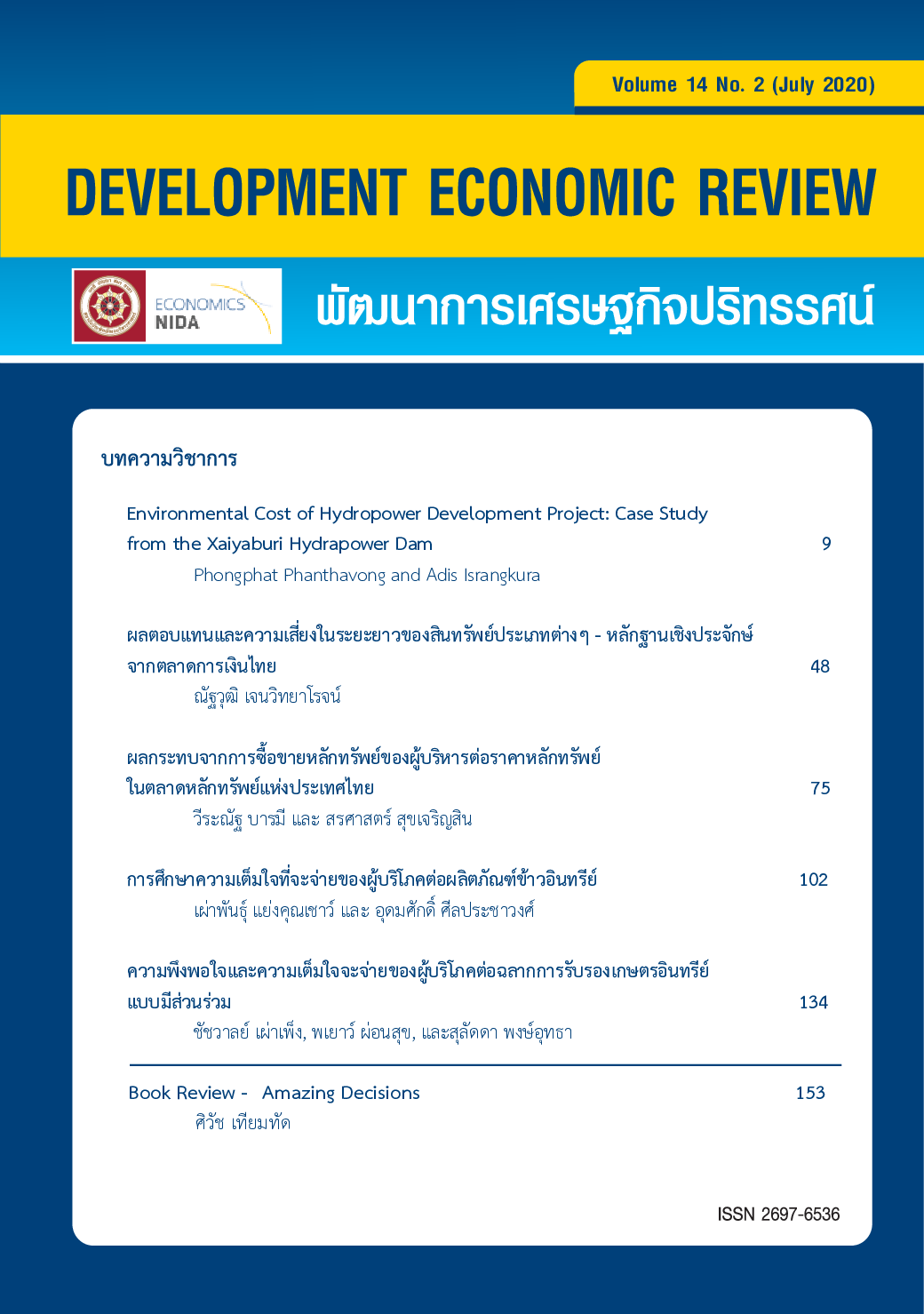Consumer’s Willingness to Pay for Organic Rice Product
Keywords:
Willingness to pay, Contingent Valuation Method, Organic RiceAbstract
This study aims to evaluate the health and environmental benefits of organic rice products using the environmental economics valuation technique. By introducing the contingent valuation method and the utility difference model to elicit willingness to pay of organic rice consumers and to investigate the socio-economic determinants of the willingness to pay from 620 samples. The study was divided into two categories in accordance with the characteristics of the products which are health benefit and environmental benefit. The results show that Bangkok and Metropolis consumers are willing to pay more for organic rice products with features that are beneficial to health, can call the value are private or individual benefits than environmental, which can interpret the value are the Payment for Ecosystem Services. In addition, the socio-economic factors: status of works, initial bid (price), average household income per head show statistical significance on consumer’s willingness to pay.
References
National Organic Development Strategy Committee (2017). National Organic Development Strategic Plan (2017-2022). Retrieved from http://planning.dld.go.th/th/images/stories/section-5/2560/strategy11.pdf. (In Thai)
อุดมศักดิ์ ศีลประชาวงศ์. (2556). การประเมินมูลค่าทางเศรษฐศาสตร์ของทรัพยากรสิ่งแวดล้อม. กรุงเทพมหานคร พี.เอ.ลิฟวิ่ง.
Udomsak Seenprachawong.(2556),Economic Valuationof Environmental Resources,Bangkok: PA Living Printing. (In Thai)
Ara, S. (2002). Environmental Evaluation of Organic Rice: A Case Study in the Phillippines. Retrieved from http://www.shihomiaksoy.org/shihomi/MAThesis.pdf.
George, S. (2010). Willingness to Pay for Locally Grown and Organically Produced Fruits and Vegetables in Dominica. Retrieved from https://tigerprints.clemson.edu/cgi/viewcontent.cgi?article=1874&context=al.
Hanemann, W. M. (1984). Welfare Evaluations in Contingent Valuation Experiments with Discrete Responses. American Journal of Agricultural Economics, 66(3), 332-341.
Díaz, F. J., Pleite, F M-C., Paz, J. M. M. & García, P. G. (2012). Consumer Knowledge, Consumption, and Willingness to Pay for Organic Tomatoes. British Food Journal, 114(3), 318-334.
Kalogeras, N., Valchovska, S., Baourakis, G., & Kalaitzis, P. (2009). Dutch Consumers’ Willingness to Pay for Organic Olive Oil. Journal of International Food & Agribusiness Marketing, 21(4), 286-311.
Kim, K-H., Kabir, E., & Jahan, S. A. (2017). Exposure to pesticides and the associated human health effects. Sci Total Environ, 575(1), 525-535.
Posri, W., Shankar, B., & Chadbunchachai, S. (2006). Consumer Attitudes Towards and Willingness to Pay for Pesticide Residue Limit Compliant “Safe” Vegetables in Northeast Thailand. Journal of International Food & Agribusiness Marketing, 19(1), 81-101.
Roy, R. (2009). Consumer Valuation of Food Attributes: A Comparison of Willingness to Pay Estimates from Choice Modelling and Contingency Valuation Methods. Retrieved from https://www.researchgate.net/publication/38437628_Consumer_valuation_of_food_attributes_a_comparison_of_willingness_to_pay_estimates_from_choice_modelling_and_contingency_valuation_methods.
Vanit-Anunchai, C. (2006). Possibilities and Constraints of Marketing Environmentally Friendly Produced Vegetables in Thailand. Retrieved from https://www.repo.uni-hannover.de/bitstream/handle/123456789/6866/51873188X.pdf?sequence=1&isAllowed=y.
Downloads
Published
Issue
Section
License
Copyright to published manuscripts becomes the property of the Graduate School of Development Economics, National Institute of Development Administration. Reproduction of all or part of a Development Economic Review (DER) article by anyone, excluding author(s), is prohibited, unless receiving our permission.
Disclaimer: Opinions expressed in articles published in this journal are those of the author (s) and do nto necessarily represent opinions of the Graduate School of Development Economics, National Institute of Development Administration. Trade and proprietary names are only for identification and not constitute our endorsement.


